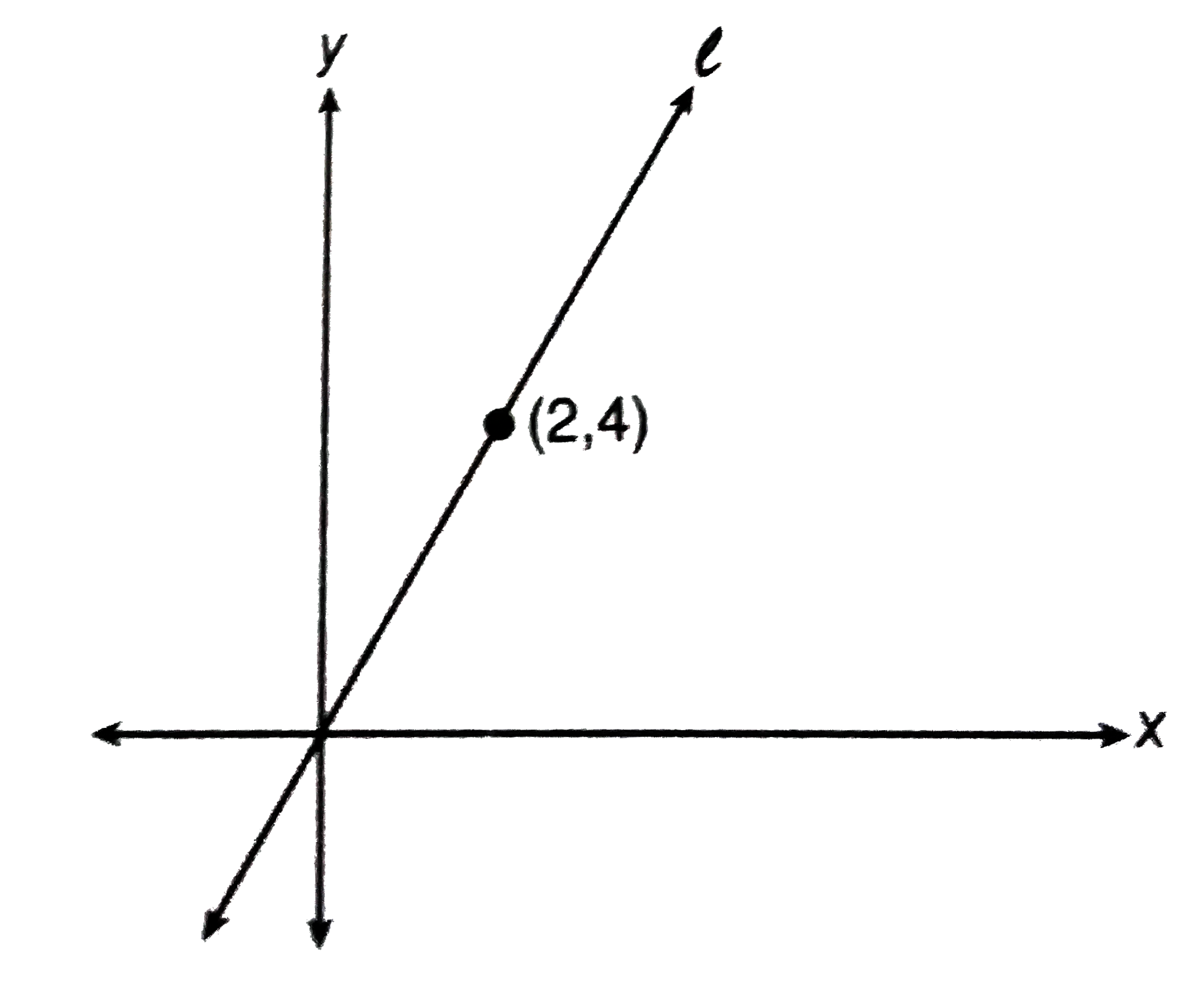A line l passing through the origin is perpendicular to the lines l1:(3+t)ˆi+(−1+2t)ˆj+(4+2t)ˆk,∞<t<∞,l2:(3+s)ˆi+(3+2s)ˆj+(2+s)ˆk,∞<t<∞ then the coordinates of the point on l2 at a distance of √17 from the point of intersection of l&l1 is/are:
To solve the problem, we will follow these steps:
Step 1: Determine the direction vectors of lines l1 and l2.
The line l1 can be expressed in vector form as:
r1=(3+t)^i+(−1+2t)^j+(4+2t)^k
From this, we can extract the direction vector of l1:
d1=dr1dt=^i+2^j+2^k
The line l2 can be expressed as:
r2=(3+s)^i+(3+2s)^j+(2+s)^k
From this, we can extract the direction vector of l2:
d2=dr2ds=^i+2^j+^k
Step 2: Find a direction vector for line l.
Since line l is perpendicular to both lines l1 and l2, we can find a direction vector for l by taking the cross product of the direction vectors d1 and d2.
Calculating the cross product:
d1=⎛⎜⎝122⎞⎟⎠,d2=⎛⎜⎝121⎞⎟⎠
d=d1×d2=∣∣
∣
∣∣^i^j^k122121∣∣
∣
∣∣
Calculating the determinant:
d=^i(2⋅1−2⋅2)−^j(1⋅1−2⋅2)+^k(1⋅2−2⋅1)
=^i(2−4)−^j(1−4)+^k(2−2)
=−2^i+3^j+0^k
Thus, the direction vector of line l is:
d=−2^i+3^j
Step 3: Write the equation of line l.
Since line l passes through the origin, its vector equation can be written as:
r=t(−2^i+3^j)for some scalar t
Step 4: Find the intersection of lines l and l1.
Setting the equations of lines l and l1 equal:
t(−2^i+3^j)=(3+t)^i+(−1+2t)^j+(4+2t)^k
This gives us the system of equations:
1. −2t=3+t
2. 3t=−1+2t
3. The k component gives no constraint since l has no k component.
From the first equation:
−2t−t=3⟹−3t=3⟹t=−1
From the second equation:
3t−2t=−1⟹t=−1
Both equations yield t=−1.
Step 5: Find the point of intersection.
Substituting t=−1 into line l1:
r1(−1)=(3−1)^i+(−1−2)^j+(4−2)^k=2^i−3^j+2^k
Thus, the point of intersection is (2,−3,2).
Step 6: Find points on line l2 at a distance √17 from the intersection point.
The distance formula in 3D is given by:
d=√(x2−x1)2+(y2−y1)2+(z2−z1)2
We need to find points on line l2 such that:
d=√17
Let the point on l2 be (3+s,3+2s,2+s).
Setting up the distance equation:
√((3+s)−2)2+((3+2s)+3)2+((2+s)−2)2=√17
Squaring both sides:
((1+s)2+(6+2s)2+s2)=17
Expanding:
(1+2s+s2)+(36+24s+4s2)+s2=17
Combining like terms:
6s2+26s+37−17=0⟹6s2+26s+20=0
Dividing through by 2:
3s2+13s+10=0
Step 7: Solve the quadratic equation.
Using the quadratic formula:
s=−b±√b2−4ac2a=−13±√169−1206=−13±√496=−13±76
Calculating the roots:
1. s1=−66=−1
2. s2=−206=−103
Step 8: Find the coordinates of the points on l2.
For s1=−1:
(3−1,3−2,2−1)=(2,1,1)
For s2=−103:
(3−103,3−203,2−103)=(−13,−113,−43)
Final Answer:
The coordinates of the points on line l2 at a distance of √17 from the point of intersection of l and l1 are:
1. (2,1,1)
2. (−13,−113,−43)
r1=(3+t)^i+(−1+2t)^j+(4+2t)^k
From this, we can extract the direction vector of l1:
d1=dr1dt=^i+2^j+2^k
r2=(3+s)^i+(3+2s)^j+(2+s)^k
From this, we can extract the direction vector of l2:
d2=dr2ds=^i+2^j+^k
d1=⎛⎜⎝122⎞⎟⎠,d2=⎛⎜⎝121⎞⎟⎠
d=d1×d2=∣∣
∣
∣∣^i^j^k122121∣∣
∣
∣∣
Calculating the determinant:
d=^i(2⋅1−2⋅2)−^j(1⋅1−2⋅2)+^k(1⋅2−2⋅1)
=^i(2−4)−^j(1−4)+^k(2−2)
=−2^i+3^j+0^k
Thus, the direction vector of line l is:
d=−2^i+3^j
r=t(−2^i+3^j)for some scalar t
t(−2^i+3^j)=(3+t)^i+(−1+2t)^j+(4+2t)^k
This gives us the system of equations:
1. −2t=3+t
2. 3t=−1+2t
3. The k component gives no constraint since l has no k component.
−2t−t=3⟹−3t=3⟹t=−1
3t−2t=−1⟹t=−1
r1(−1)=(3−1)^i+(−1−2)^j+(4−2)^k=2^i−3^j+2^k
Thus, the point of intersection is (2,−3,2).
d=√(x2−x1)2+(y2−y1)2+(z2−z1)2
We need to find points on line l2 such that:
d=√17
Let the point on l2 be (3+s,3+2s,2+s).
√((3+s)−2)2+((3+2s)+3)2+((2+s)−2)2=√17
Squaring both sides:
((1+s)2+(6+2s)2+s2)=17
Expanding:
(1+2s+s2)+(36+24s+4s2)+s2=17
Combining like terms:
6s2+26s+37−17=0⟹6s2+26s+20=0
Dividing through by 2:
3s2+13s+10=0
s=−b±√b2−4ac2a=−13±√169−1206=−13±√496=−13±76
Calculating the roots:
1. s1=−66=−1
2. s2=−206=−103
(3−1,3−2,2−1)=(2,1,1)
(3−103,3−203,2−103)=(−13,−113,−43)
The coordinates of the points on line l2 at a distance of √17 from the point of intersection of l and l1 are:
1. (2,1,1)
2. (−13,−113,−43)
Topper's Solved these Questions
Similar Questions
A line l passing through the origin is perpendicular to the lines
1:(3+t)ˆi+(−1+2t)ˆj+(4+2t)ˆk−∞<t<∞and1_(2):(3+2s)ˆi+(3+2s)ˆi+(3+2s)ˆj+(2+s)ˆk,−∞<s<∞
Then the coordinate(s) of the point(s) on 12 at a distance of √17 from the point of intersection of 1 and 11 is (are)
View SolutionFind the equation of a line passing through the point (1,2,3) and perpendicular to the plane →r.(2ˆi−3ˆj+4ˆk)=1.
View SolutionFind the vector equationof the line passing through the point (3,1,2) and perpendicular to the plane →r.(2ˆi−ˆj+ˆk)=4. Find also the point of intersection of this line and the plane.
View SolutionFind the equation of the plane passing through the point ˆi−ˆj+ˆkand perpendicular to the vectro 3ˆi−ˆj−2ˆk and show that the point 2ˆi+4ˆj lies on the plane.
View SolutionFind the equation of a plane passing through origin and which is perpendicular to a normal vector
2ˆi+ˆj−ˆk. (Cartesian form )
View SolutionFind the equation of the line which passes through the point (-1,3,-2) and is perpendicular to the lines x1=y2=z3 and →r=(−2ˆi+ˆj−ˆk)+λ(−3ˆi+2ˆj+5ˆk).
View SolutionIf a line passing through (−2,1,α) and (4, 1, 2) is perpendicular to the vector 3ˆi−4ˆj+5ˆk and parallel to the plane containing vectors ˆi+2βˆk and 2βˆi+αˆk(∀β≠0), then 10(α+β) is equal to
View SolutionThe line passing through (-4, -2) and (2, -3) is perpendicular to the line passing through (a, 5) and (2, -1). Find a.
View SolutionThe area (in square units ) of the triangle formed by y-axis , the straight line L passing through (1,1) and (2,0) and the straight line perpendicular to the line L and passing through (1/2, 0) , is
View Solution
In the accompanying figure. Line l passes through the origin and the point (2, 4). Line m (not shown) is perpendicular to line l at (2, 4). Line m intersects the x-axis at which point?
View Solution
